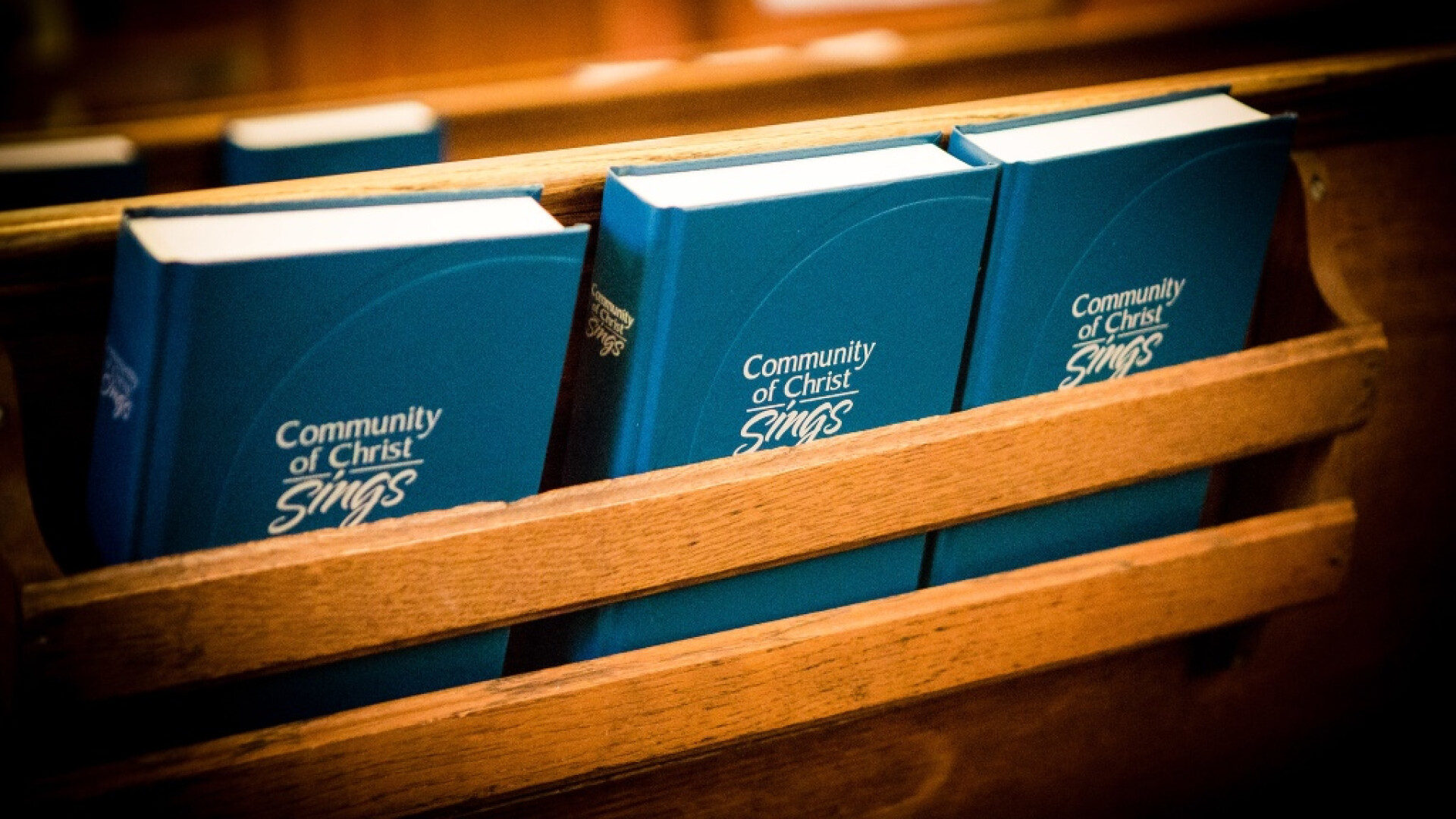Stop 1
Welcome and Instructions
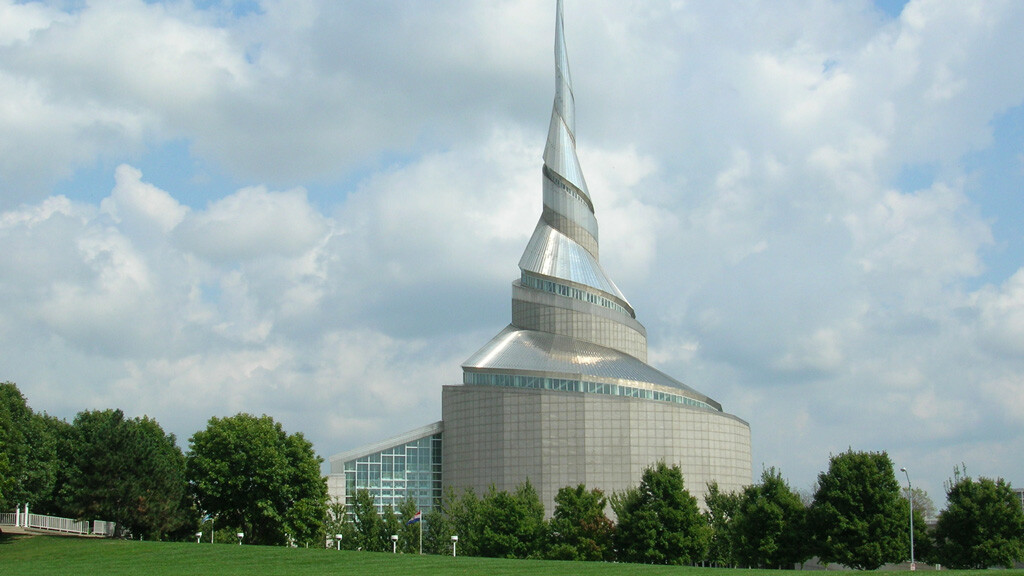
Welcome to the Community of Christ Temple. We will see the Meditation Chapel which overlooks a garden designed by master gardeners from Japan and an award-winning stained-glass window during the tour. We will also follow the Worshiper’s Path, filled with symbolic artwork, see the 1,600-seat Temple Sanctuary, featuring a spiral ceiling rising 195 feet and the 102-rank, 5,685-pipe organ.
Tap "Welcome Recording" below to begin the tour.
Welcome Recording
Transcript
Tour Guide
Welcome to the Community of Christ Temple audio tour. My name is Catherine Mambwe. I serve as a member of the Council of 12 Apostles. I will be one of your guides today, so listen for my voice to help you as you move from one space to another.
This is a self-guided tour, so you may go at your own pace. Feel free to spend time in contemplation at any point.
Community of Christ acknowledges the First Peoples of America that were present in this area when the early church members settled here.
We have initiated a process that will honor the tribal peoples’ presence here in Independence, and their respectful stewardship of this land.
Moving forward, as current caretakers of this sacred land, we will continue the restoring and healing of relationships.
Wallace B. Smith
I’m Wallace B. Smith, President Emeritus of Community of Christ, and great-grandson of church founder Joseph Smith Jr.
Welcome to the Community of Christ Temple, dedicated to the pursuit of peace, and open to all people. This Temple is part of the church’s international headquarters and is a place of worship, education, community building, discipleship preparation, and church administration. The Temple is an important part of our mission to proclaim Jesus Christ and promote communities of joy, hope, love and peace.
This Temple was formally dedicated in 1994, though the dream of a Temple has been a part of our church heritage since 1831.
Tour Guide
To hear more about the history of the Temple, select “What Happened in 1831?”
You may also exit the theater and select “Temple Foyer Cross” to continue the tour.
What Happened in 1831?
Transcript
Narrator
In response to divine direction, church founder Joseph Smith Jr. and other leaders, journeyed from the church’s Kirtland, Ohio headquarters to Independence, Missouri, in June of 1831. Shortly after their arrival, they dedicated a wooded grove as the site of a future temple, the 63-acre tract on which this Temple now stands. The Temple Lot Property, as it was known, cost $130. The site where this purchase was negotiated, the Flournoy House, still stands and is now located Northwest of the Temple in the Heritage Plaza.
Though conflict with area settlers drove the church from Missouri a few years later, church members began returning by 1860. In 1920, church headquarters was officially established in Independence. Inspired Counsel, given in 1984 by church Prophet-President Wallace B. Smith, Joseph’s great-grandson, directed that construction of this temple begin.
Tour Guide
Please exit the theater now, and proceed to the wooden cross, located in the Temple Foyer. Select “Temple Foyer Cross” to continue the tour.
Stop 2
Wooden Cross
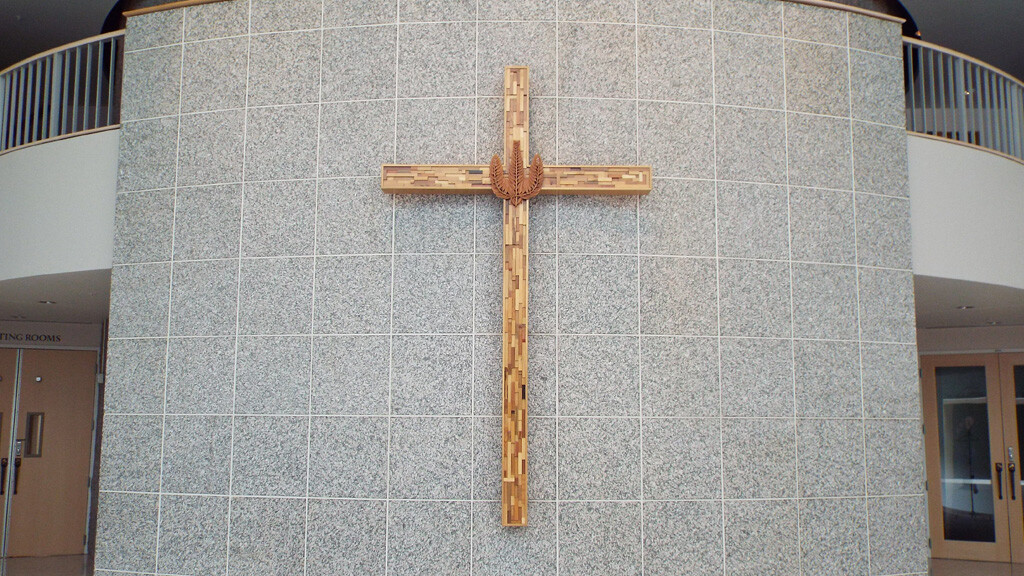
The cross is made from more than 100 types of wood from around the world, representing more than 50 nations where the church has a presence. The olive branches at the center take the form of a descending dove, symbolizing peace. Artist: David Martin
Temple Foyer Cross
Transcript
Narrator
We begin our tour in the foyer of the Temple. The South wall is graced with an 11-foot mosaic cross, assembled from 110 types of wood donated by church members from all over the world.
The cross affirms that we are bound together with Christians in every place and in every time by our confession of Jesus Christ, son of the living God, author of our salvation, and head of the church. Christ is our peace; breaking down the walls of hostility between us, promising redemption, and the healing of our relationships with God, one another, and all of creation.
Community of Christ has a presence in over 60 nations. Like the many single wooden pieces in the cross, the church is a richly diverse community of disciples of different ages, cultures, and circumstances from around the world. This diversity is represented in the church’s Council of Twelve, composed of Apostles from different countries around the globe.
In the center of the cross, three olive branches form the shape of a descending dove. The dove and the olive branches, like the Temple itself, are symbols of peace. This cross hangs on the outer wall of the Temple Meditation Chapel.
Tour Guide
Please enter the Meditation Chapel, located directly behind the cross. There are doors that enter from the right or left-hand side.
Stop 3
Meditation Chapel
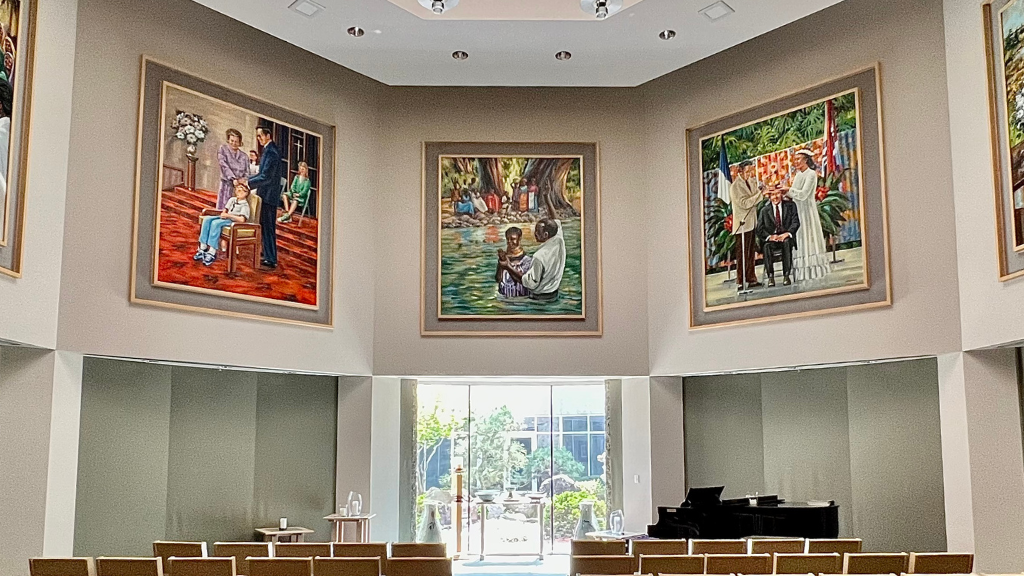
The chapel is available for personal meditation and prayer. Its walls feature oil paintings in settings throughout the world of the church’s eight sacraments: baptism, confirmation, Communion, marriage, blessing of children, laying on of hands for the sick, evangelist blessing, and ordination. Artist: Jack Garnier
Meditation Chapel
Transcript
Narrator
The chapel is an octagonal space intended for small group worship and individual meditation. Large oil paintings depicting the sacraments of the church encircle the walls. These sacred rites invite us into relationship with God. Through the sacraments, we experience God’s love, grace, and unity within the Body of Christ.
Beginning with the painting above the window and continuing to your left, the sacraments depicted are Baptism in Africa, Confirmation in Australia, The Lord’s Supper, or Communion, in India, Marriage in Japan, the Blessing of Children in Mexico, Laying on of Hands for the Sick in Haiti, the Evangelist’s Blessing in the United States, and Ordination in French Polynesia.
These sacraments are an important part of the life of the church. They occur around the world. None of the sacraments are required to take place in the Temple, and everyone is welcome to participate in the sacraments of Community of Christ. Membership is only required when persons are called to be ordained into the priesthood.
The main window of the Chapel looks out on a lovely, tranquil Japanese-style Meditation Garden.
Tour Guide
Select “The Sacraments” to hear more about sacraments in Community of Christ.
Otherwise, select “Meditation Garden” to continue the tour.
The Sacraments
Transcript
Narrator
We begin with the painting above the window and continue to your left. We begin with the painting above the window and continue to your left.
Baptism by immersion in an African river is symbolic of the new member’s covenant with Christ. Baptism is an outward symbol of transformation within, a deep desire to align our lives with the vision of human life taught by Jesus. Baptism takes place in various settings—in a church building, a natural body of water, or a swimming pool. To its left, we see a scene from the Confirmation ceremony in Australia in which a new member receives the gift and promise of the Holy Spirit. Confirmation of membership follows Christian commitment in the waters of baptism.
Communion, seen here in India, renews our covenant with Christ. The bread and wine of the Lord’s Supper are in remembrance of the body and blood of Jesus.
The wedding we see here takes place in Japan. In the sacrament of marriage, two individuals covenant to express their discipleship and life’s purpose together.
The painting above the chapel entrance shows the blessing of a baby in Mexico. Blessing children recognizes our commitment to follow Jesus’ example by welcoming, guiding, and nurturing children as a valuable part of the church community. God’s vision for the world begins with the most vulnerable.
In the Laying on of Hands for the Sick, we pray for God’s comfort, peace, and wholeness, for those who are ill or suffering, here pictured in Haiti. The Evangelist Blessing, depicted here in the United States, provides guidance and encouragement to individuals, couples, families, households, groups, and congregations throughout their life journey.
To its left is an Ordination to Community of Christ priesthood in French Polynesia. The church’s lay priesthood is made up of those called and ordained into ministry.
Tour Guide
Select “Meditation Garden” to continue the tour.
Stop 4
Meditation Garden
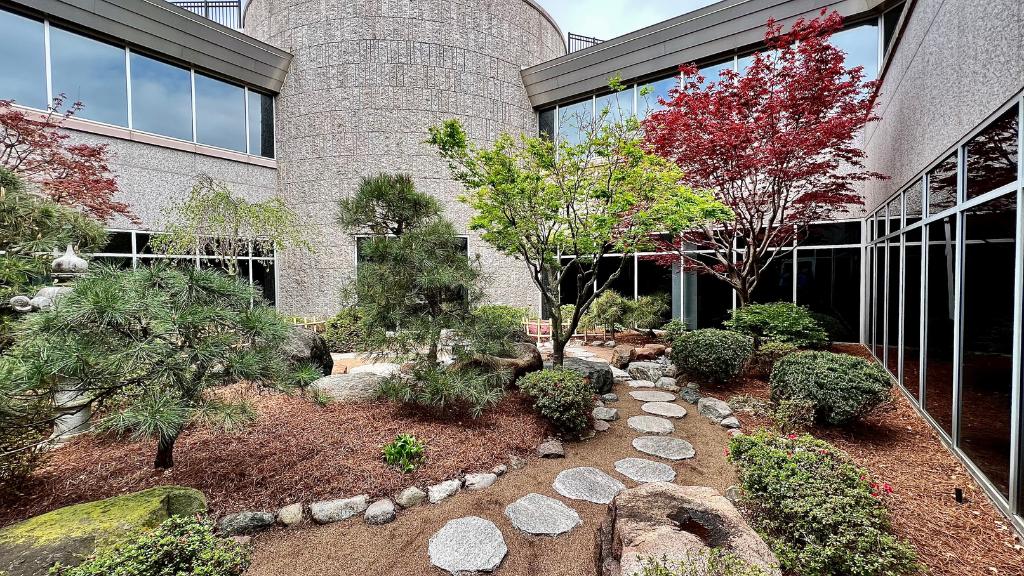
The garden was a gift from the church members and friends of the church in Japan. It was established by a team of six gardeners from Higashimurayama, Japan, the sister city of Independence, Missouri, USA.
Meditation Garden
Transcript
Narrator
Welcome to the Meditation Garden. May it bring you peace and wholeness.
From the chapel, you can view an intimate meditation garden donated by members of the church in Japan. The garden was created in August 1992 by six landscape artists from Higashimurayama, Japan, the sister city of Independence, Missouri, and was completed in less than a week.
This peaceful setting offers a focal point for contemplation. Glass walls surround the garden, allowing those inside the Temple’s halls to share in its tranquility.
Tour Guide
Please exit the chapel and cross the foyer to the North, stopping in front of the carved glass entrance. Select “Worshipper’s Path” to continue the tour.
Stop 5
Worshiper's Path
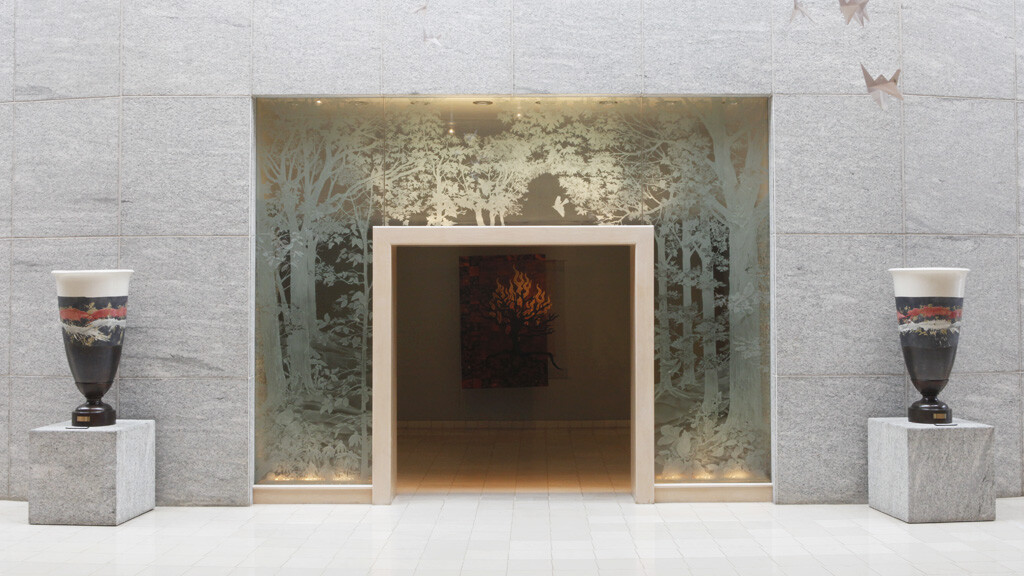
The journey up the Worshiper’s Path offers time to reflect and prepare to encounter the Divine. Light increases as worshipers travel the path, symbolizing the spiritual light available to all through the grace of God.
Worshiper's Path
Transcript
Narrator 1
The Worshipper’s Path is an ascending spiral passage with gradually increasing illumination that leads into the Temple sanctuary. The 150-foot path rises a full story on its journey.
Narrator 2
Panels of carved glass surround the entrance to the Worshipper’s Path and mark the start of a sequence of artwork designed to prepare us for worship. Both sides of the glass are carved with images of plants and wildlife common to the New York grove, where, in the Spring of 1820, young Joseph Smith Jr. sought God’s guidance in a prayerful experience that led to the founding of this church.
We affirm God is always with us and welcomes those who seek divine counsel and wisdom.
In Community of Christ, we have a spiritual practice that helps us seek direction for the day. We call it the Mission Prayer:
“God, where will your Spirit lead today? Help me be fully awake and ready to respond. Grant me courage to risk something new, and become a blessing of your love and peace.”
Tour Guide
To hear artist Kathy Barnard describe the etching process, select “’The Sacred Grove’ Carving Process by Artist Kathy Barnard.”
Stop 6
The Grove
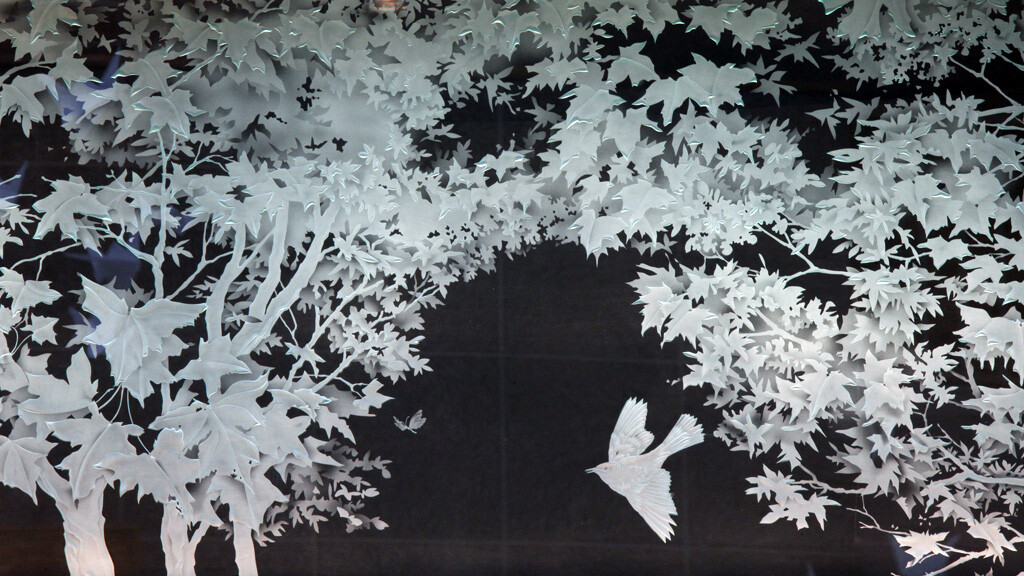
Layers of carved glass represent the wooded grove in New York where Joseph Smith Jr. had a prayerful experience that led him to found this church. It beckons worshipers toward the sanctuary as they seek their own encounters with the Divine. “If any of you is lacking in wisdom, ask God” (James 1:5 NRSV). Artist: Kathy Barnard
"The Sacred Grove" Carving Process by Artist Kathy Barnard
Transcript
Narrator
I mask off the glass or the granite with material that resists, that will hold up to the pressure of the sand blasting and the cutting of the grit. I put my drawing on that mask and then I cut out all the areas with like with a scalpel or Exacto blade.
Then I take off the mask, like a stencil; taking off the piece that I am going to carve the deepest, first. I carve that. Stop. Take off another piece of mask, carving that area, making sure I don’t destroy what I have just done in the piece before.
So, as the piece progresses and more and more pieces of the mask and stencil are removed, more of the piece is created.
At the end, the only mask that is left on the piece is the clear areas.
Tour Guide
Select “The Burning Bush” to continue the tour.
Stop 7
The Burning Bush
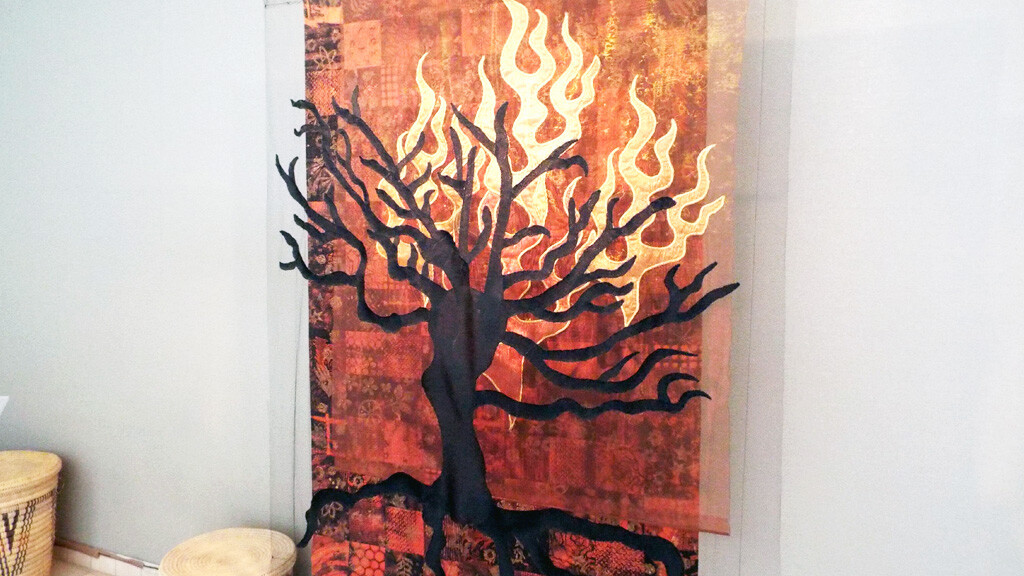
The multidimensional textile reminds us of God’s call to Moses found in the Old Testament. God called to him out of a bush. “Moses! Moses!” He looked, and the bush was blazing, yet it was not consumed. Take off your sandals, “for the place on which you are standing is holy ground” (Exodus 3:4–5 NRSV). Artist: Linda Henke
The Burning Bush
Transcript
Narrator
The Burning Bush, a dimensional tapestry, recalls the biblical account of the bush ablaze but not consumed by fire. From this bush, God called out to Moses to free the oppressed people of Israel from their Egyptian captors. Like Moses, all are called to God’s work and reminded that here, we walk on Holy ground.
The account of the burning bush is in the Old Testament or Hebrew Scripture, another name for the first portion of the Christian Bible. With other Christians, we affirm the Bible as the foundational scripture for the church. We also use the Book of Mormon and Doctrine and Covenants as scripture, not to replace or improve on the witness of the Bible but because they confirm the biblical messages that Jesus Christ is the living word of God.
Tour Guide
To hear the Old Testament account of Moses and the Burning Bush, select “The Story of Moses and the Burning Bush.”
The Story of Moses and the Burning Bush
Transcript
Narrator
Moses was keeping the flock of his father-in-law Jethro, the priest of Midian; he led his flock beyond the wilderness, and came to Horeb, the mountain of God. There, the angel of the Lord appeared to him in a flame of fire out of a bush; he looked, and the bush was blazing, yet it was not consumed. Then Moses said:
Moses
I must turn aside and look at this great sight and see why the bush is not burned up.
Narrator
When the Lord saw that he had turned aside to see, God called to him out of the bush.
God
Moses, Moses! Here I am. Come no closer! Remove the sandals from your feet, for the place on which you are standing is holy ground I am the God of your father, the God of Abraham, the God of Isaac, and the God of Jacob.
Narrator
And Moses hid his face, for he was afraid to look at God.
God
I have observed the misery of my people who are in Egypt; I have heard their cry on account of their taskmasters. Indeed, I know their sufferings, and I have come down to deliver them from the Egyptians, and to bring them up out of that land to a good and broad land, a land flowing with milk and honey, to the country of the Canaanites, the Hittites, the Amorites, the Perizzites, the Hivites, and the Jebusites. The cry of the Israelites has now come to me; I have also seen how the Egyptians oppress them. So come, I will send you to Pharaoh to bring my people, the Israelites, out of Egypt.
Tour Guide
Select “Once was lost… now is found” to continue the tour.
Stop 8
The Prodigal
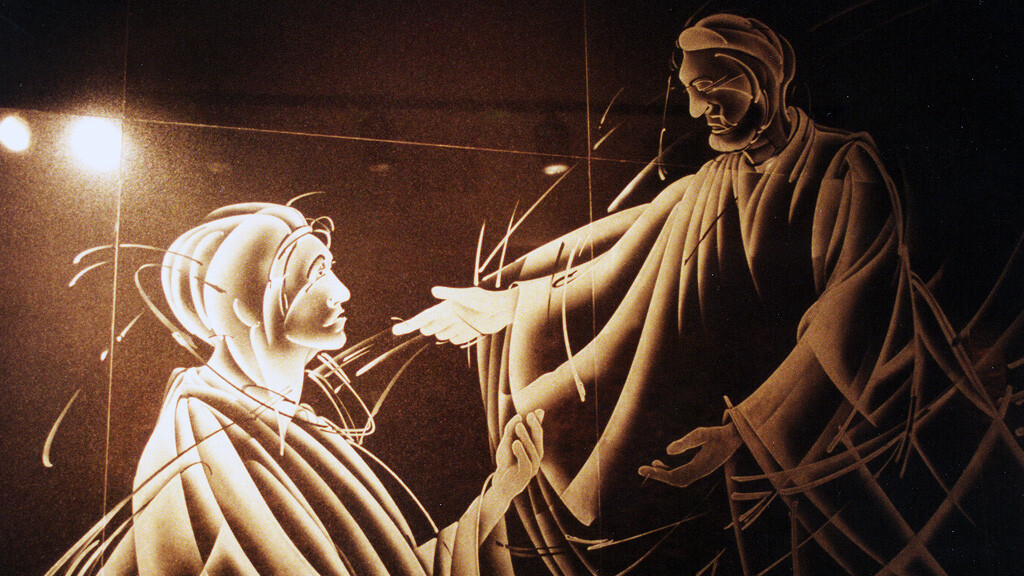
A black, granite carving represents the story Jesus shared about a young man who made some poor life choices but was welcomed home by his forgiving father. The parable of the prodigal son assures us God always will accept us with open arms. “…for this son of mine was dead and is alive again; he was lost and is found!” (Luke 15:24 NRSV). Artist: Kathy Barnard
Once was lost… now is found
Transcript
Narrator
An 11 x 17-foot stone carving in 12 panels of black granite depicts the parable of the Prodigal Son. Jesus told this story of a young man, who despite deserting his family and making some poor choices, is welcomed home by his father. Look closely at this granite sculpture and you might see your own reflection. We all have experienced times of estrangement from God when we chose not to live up to our divinely given potential. Like the father of the prodigal, God always welcomes the lost and the seeking.
Tour Guide
Select one of the options for the Prodigal Son exhibit, or select “The Shadow of the Cross” to continue the tour.
Select one of the options for the Prodigal Son exhibit, or select “Jesus the Teacher” to continue the tour.
Material Used for The Prodigal Son
Transcript
Narrator
We used polished black granite with the thought that it would be reflective and as you view the piece you would also see yourself reflected in the piece, and perhaps you could put yourself in the image of the son as the one asking for forgiveness or the image of the father as the one giving forgiveness.
Tour Guide
Select another option for the Prodigal Son exhibit, or select “The Shadow of the Cross” to continue the tour.
Select another option for the Prodigal Son exhibit, or select “Jesus the Teacher” to continue the tour. (backup for eventual exhibit)
Story of the Prodigal Son
Transcript
Narrator
Position yourself in a way that you can see your reflection in the granite. As you listen to this story, or as you recall it from your memory, think of times when you have felt “lost,” when you have yearned to go “home.”
There was a man who had two sons, The younger of them said to his father:
Son
Father, give me the share of the property that will belong to me.
Narrator
So, he divided his property between them. A few days later, the younger son gathered all he had and traveled to a distant country, and there he squandered his property in dissolute living. When he had spent everything, a severe famine took place throughout that country, and he began to be in need. So, he went and hired himself out to one of the citizens of that country, who sent him to his fields to feed the pigs. He would gladly have filled himself with the pods that the pigs were eating; and no one gave him anything. But when he came to himself, he said:
Son
How many of my father’s hired hands have bread enough and to spare, but here I am dying of hunger! I will get up and go to my father, and I will say to him, “Father, I have sinned against heaven and before you; I am no longer worthy to be called your son; treat me like one of your hired hands.”
Narrator
So, he set off and went to his father. But while he was still far off, his father saw him and was filled with compassion; he ran and put his arms around him and kissed him.
Son
Father, I have sinned against heaven and before you; I am no longer worthy to be called your son.
Narrator
But the father said to his slaves:
Father
Quickly, bring out a robe—the best one—and put it on him; put a ring on his finger and sandals on his feet. And get the fatted calf and kill it and let us eat and celebrate; for this son of mine was dead and is alive again; he was lost and is found!
Narrator
And they began to celebrate.
Tour Guide
Select another option for the Prodigal Son exhibit, or select “The Shadow of the Cross” to continue the tour.
Select another option for the Prodigal Son exhibit, or select “Jesus the Teacher” to continue the tour. (backup for eventual exhibit)
Jesus the Teacher
Transcript
Narrator
Throughout his life, Jesus used stories to teach not only his own disciples, but all who would hear about God’s love and justice. The Bible recounts many instances of Jesus’ teaching ministry. When he was only twelve years old, his parents found him in the temple conversing with the religious teachers, who were amazed at his understandings. As an adult, he taught a lesson known as the Sermon on the Mount, which challenged a large crowd of listeners to rethink their understandings of status and religious requirements.
We recognize the instruction found in Jesus’ teachings is not limited by history and geography, but has universal value for all people, in all times and places. We read and discern the teachings of Jesus as we study the scriptures.
Tour Guide
Select “The Shadow of the Cross” to continue the tour.
Stop 9
The Cross
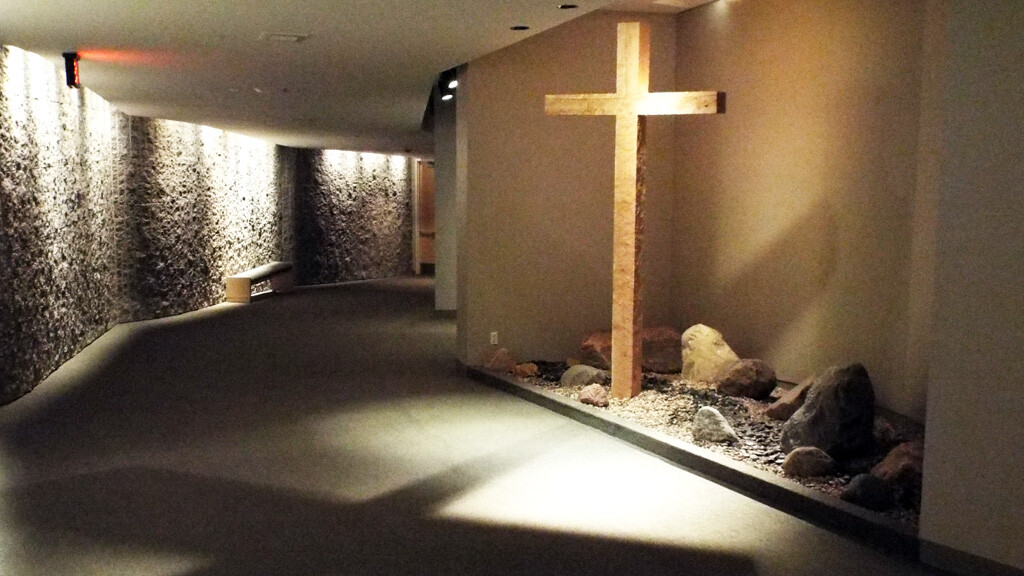
For Christians, God’s love and grace are embodied in the sacrificial life and death of Jesus. Worshipers walk through the shadow of the rough-hewn cross, which is empty, proclaiming the risen Christ. Jesus said “…take up [your] cross, and follow me” (Mark 8:34 NRSV, adapted). Artists: John Weller and Lee Sampson
The Shadow of the Cross
Transcript
Narrator
Proceeding up the pathway, we walk through the shadow of a simple, rough-hewn cross. The cross on which Jesus died was neither ornate nor aesthetically pleasing. It was constructed simply for the purpose of being an instrument of death. Yet, through the resurrection of Jesus, God turned this instrument of death into a sign of divine love and forgiveness. The empty cross came to stand for the eternal life and endless possibility that emerges from God’s gracious love.
We see the shadow of the cross even before we see the cross itself. God’s love and grace is present to us, even before we recognize it. Our God is always inviting and extending love and grace to us. As followers of Jesus Christ, we are faced with this question posed by John Bell, 2013 Community of Christ International Peace Award recipient, in his hymn, The Summons, “Will you come and follow me if I but call your name?” The shadow of the cross is always before us on life’s way. It is a sign of hope, life, and divine love, not an instrument of oppression or force.
Tour Guide
Select “Tree of Life” to continue the tour.
Stop 10
Tree of Life
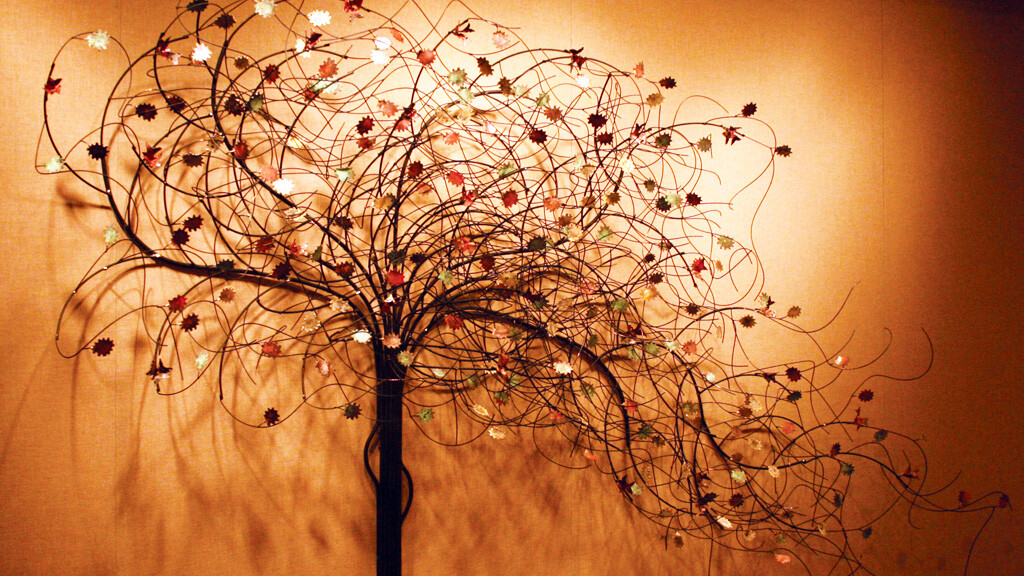
This brass, copper, and steel sculpture inspires images about new life, bringing forth good fruit, and spiritual growth. The movement of the leaves inspires the worshiper to continue to journey toward spiritual encounter with the Divine. “…the leaves of the tree are for the healing of the nations” (Revelations 22:2 NRSV). Artist: Suat Gurtan
Tree of Life
Transcript
Narrator
The Tree of Life is mentioned many times in the scriptures as a metaphor for the living, growing presence of God’s love in our lives. In the Gospel of John, Jesus says, “I am the true vine, and my Father is the vine grower.”
The Tree of Life is a sign that all of life comes from God, and through Jesus we are promised a life that is abundant in those things that really matter. This sculpture is made of stainless steel, copper, and brass. The variety of metals and finishes used is symbolic of our wonderous diversity, and the movement of the leaves as we pass symbolizes our continuous growth and change as we pursue a life of faithful discipleship.
Tour Guide
Select “Ikebana” to continue the tour.
Stop 11
Ikebana
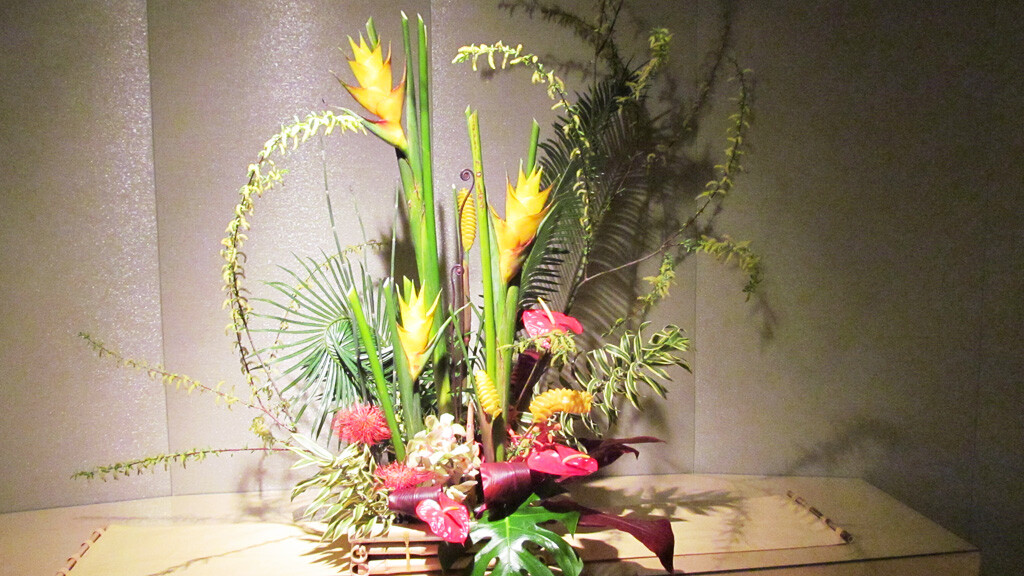
Ikebana is the Japanese art of fresh flower arranging. Three levels are placed in a well-balanced arrangement to create a feeling that heaven, humanity, and Earth are in harmony. These simple displays are designed to encourage peaceful contemplation. “For as the earth brings forth its shoots, and as a garden causes what is sown in it to spring up; so the Lord God will cause righteousness and praise to spring up before all the nations” (Isaiah 61:11 NRSV). Artists: Ikebana Ho Shi Kai (Ikebana volunteers)
Ikebana
Transcript
Narrator
The next steps bring us to a display of Ikebana, the Japanese art of flower arrangement. Volunteers follow classic principles of simplicity and harmony, balancing elements of differing heights which represent heaven, humanity, and earth. We are a vital part of creation.
We are interconnected with our earth and with the God who fashioned all. And we experience the Holy through all of creation.
Tour Guide
To learn more about the art of Ikebana, select “More about Ikebana.”
Otherwise, select “The Dark Night of the Soul” to continue the tour.
More about Ikebana
Transcript
Narrator
Ikebana is a centuries old artistic tradition. More than simply arranging flowers in a pleasing way, it is intended to evoke a restful and restorative mindfulness. Simplicity, harmony, and balance are key principles in the creation of authentic Ikebana.
In this arrangement, notice the different heights. Shin, representing heaven, reaches the highest. Soe, in the middle, symbolizes humanity. And hikae, or earth, is at the lowest level. Empty space rests the eye and is as important to the design as the branches or flowers.
A well-balanced arrangement is a focal point for calming contemplation and creates in us a sense of God’s intent that all creation coexist peacefully.
Tour Guide
Select “The Dark Night of the Soul” to continue the tour.
Stop 12
Dark Night of the Soul
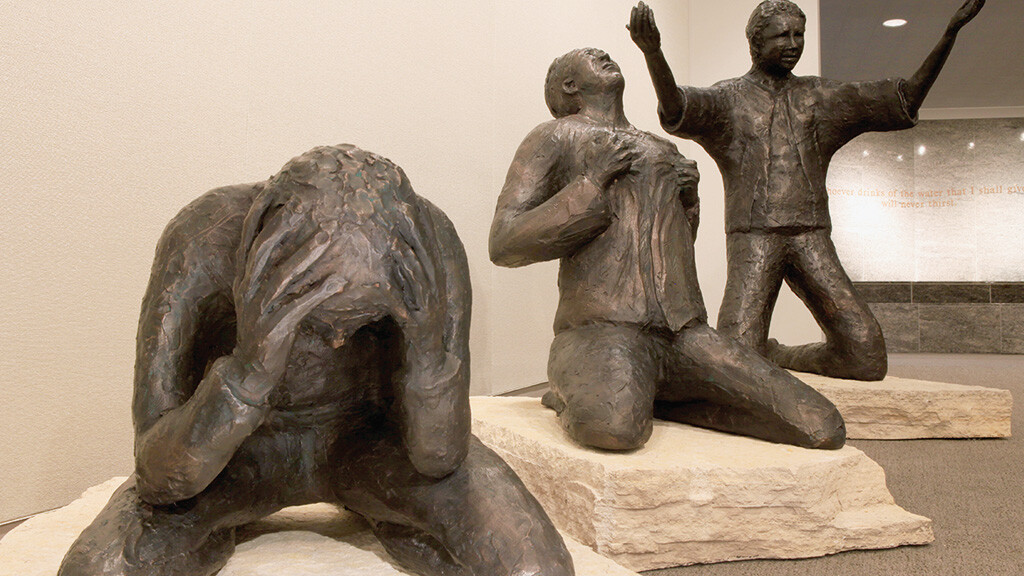
As we journey deeper into God, we may find ourselves in a time of spiritual despair called the Dark Night of the Soul. We struggle to find our way back to God and realize the spiritual oneness we seek requires complete surrender of self. As we let God heal our fear, resistance, and self-centeredness, we are freed, as God’s beloved ones, to live in deeper union with God and the way of Christ’s peace. “ Jesus cried…My God, my God, why have you forsaken me”? (Matthew 27:46). Artist: Linda Lewis
The Dark Night of the Soul
Transcript
Narrator
These three sculpted figures depict the three phases of the Dark Night of the Soul: despair, emptying, and transformation. It stands in stark contrast with many of the other stations on this path to remind us that there are times when we suffer, when we are in despair.
Even faithful disciples may experience a dark night of the soul, a crisis of fear, suffering, and doubt, when God seems distant. In the midst of this despair, we empty ourselves, making room for the transforming presence of the divine in our lives. This Temple is not just for moments of celebration. God meets us regardless of where we are on life’s journey.
In our dark and difficult moments, we are assured that our God, ever faithful, is with us and continues to love us.
Tour Guide
Select “Living Water” to continue the tour.
Select “Jesus the Healer” to continue the tour.
Stop 13
Living Water
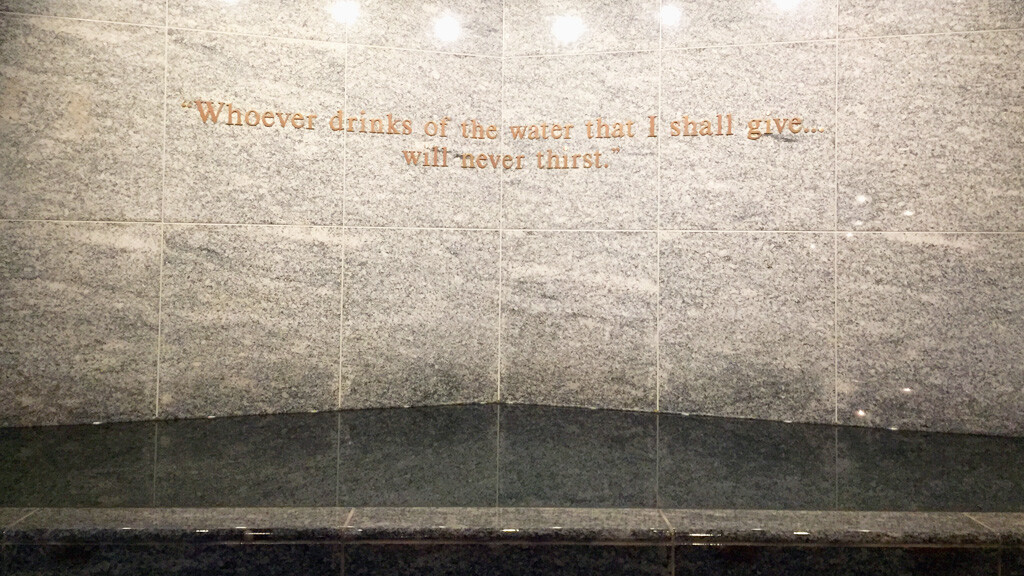
Water flows over the shelf of the granite pool, symbolizing the abundant life God has given us. The symbolic living water quenches our spiritual thirst, cleansing and soothing our soul. “The water that I will give will become in them a spring of water gushing up to eternal life” (John 4:14 NRSV).
Living Water
Transcript
Narrator
Near the top of the path is a fountain, a wide pool of water overflows its limits, cascading over a granite ledge into a basin below. The words above the fountain are Jesus’ reply to a woman drawing water to quench a physical thirst. The fountain reminds us of the living water Jesus offers to all. This overflowing water is a metaphor for God’s abundant, overflowing love for all of creation.
Tour Guide
To hear the story of Jesus and the Woman at the Well, select “Story of Jesus and the Woman at the Well.”
Story of Jesus and the Woman at the Well
Transcript
Narrator
Now when Jesus heard that the Pharisees had heard, “Jesus is making and baptizing more disciples than John”—although, it was not Jesus himself but his disciples who baptized—he left Judea and started back to Galilee. But he had to go through Samaria. So, he came to a Samaritan city called Sychar, near the plot of ground that Jacob had given to his son Joseph. Jacob’s well was there, and Jesus, tired out by his journey, was sitting by the well. It was about noon. A Samaritan woman came to draw water, and Jesus said to her,
Jesus
Give me a drink.
Samaritan Woman
How is it that you, a Jew, ask a drink of me, a woman of Samaria?
Jesus
If you knew the gift of God, and who it is that is saying to you, ‘Give me a drink,’ you would have asked him, and he would have given you living water.
Samaritan Woman
Sir, you have no bucket, and the well is deep. Where do you get that living water? Are you greater than our ancestor Jacob, who gave us the well, and with his sons and his flocks drank from it?
Jesus
Everyone who drinks of this water will be thirsty again, but those who drink of the water that I will give them will never be thirsty. The water that I will give will become in them a spring of water gushing up to eternal life.
Tour Guide
Select “Sanctuary” to continue the tour.
Select “Holy Spirit” to continue the tour.
Holy Spirit
Transcript
Narrator
As we move toward the top of the worshipers path, our eyes are drawn upward to an artwork suspended high above us. In this final moment of preparation before we enter the Temple sanctuary, we acknowledge the gift of the Holy Spirit as a comforter, companion, and guide for us in our life and ministry.
Tour Guide
Select “Sanctuary” to continue the tour.
Stop 14
Sanctuary
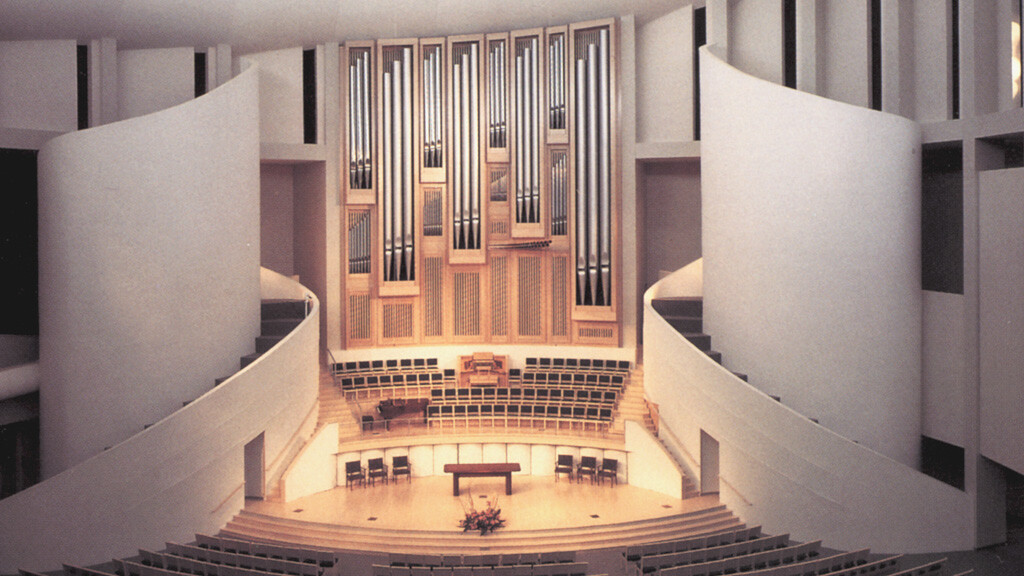
With a design based on the nautilus seashell, the ceiling rises 195 feet. Its spiral shape is found throughout nature and in human cultures throughout history. The spiral represents the inward and outward journeys of discipleship. It symbolizes the importance of our personal relationship with God and our efforts to share the peace of Jesus Christ in communities throughout the world. Principal architect: Gyo Obata Architectural firm: Hellmuth, Obata & Kassabaum
A Prayer for Peace is offered 365 days a year at 1:00 p.m. in the Temple and in many places throughout the world where people join in lifting their voices in prayer. This brief worship is open to all and serves as a powerful witness of Community of Christ’s commitment to peace. “The temple shall be dedicated to the pursuit of peace. It shall be for reconciliation and healing of the spirit” (Doctrine and Covenants 156:5a). Presiders: Volunteers
Sanctuary
Transcript
Narrator
The Worshipper’s Path leads us into the temple sanctuary. The design of this sacred space is based on the spiral of a nautilus seashell, a naturally occurring form. It represents the inward and outward journey of discipleship, our personal relationship with God, and our efforts to share the peace of Jesus Christ throughout the world.
Although the room has a friendly--almost intimate--feel, it is largely without ornamentation. This creates an environment in which the Holy Spirit can meet worshippers wherever they may be along life’s journey.
Steve Veazey
I am Steve Veazey, President of Community of Christ. Welcome to the Temple Sanctuary. Please take a moment to sit and look around you, relax, pray, if you desire. Take as much time as you’d like to experience this sacred space. We hope that in the quiet serenity of this sanctuary, you sense something of our desire to symbolize the pursuit of peace as an important aspect of our Christian witness. As part of that witness, Community of Christ invites people around the world to pause daily to pray for peace. In this practice, we seek to pray intentionally for peace—peace for me, peace for you, peace for us, and peace for the planet. Our prayer is informed by the scriptural witness that the people of God are a people of peace. We recognize significant events happening in the world, often by focusing on one particular nation or group of people in our prayer.
Tour Guide
Select one of our Temple Sanctuary options to hear more about this space.
Otherwise, exit the doors to the right and select “Redeemer of the World” to continue the tour.
Hear More About This Space
Transcript
Narrator
The spiral above us invites our attention upward, it lifts our vision toward higher things. We become aware that we have moved into sacred space.
The design imitates things we might find in nature. In nature, spirals are quite common—in a nautilus shell, for example, which served as an inspiration for this design. It is also present in certain plants and animals, in the flow of water, and in the design of galaxies, even in the structure of our own DNA.
Here, new possibilities can be imagined, traced out, and given all sorts of color as we are drawn into new realities.
The spiral is meant to remind us of how closely we are connected to God and to all of creation. We are led on an inward journey that also leads us outward as we seek to be a blessing to others, to our world, and to God. Here we may find guidance and inspiration. It is a space of discernment. We rest for a while in recognition of God’s peace. Then, we are called to move out and be Christ’s mission in the world.
Tour Guide
Select one of our Temple Sanctuary options to hear more about this space.
Otherwise, exit the doors to the right and select “Redeemer of the World” to continue the tour.
The Prayer for Peace
Transcript
Narrator
Beginning in December 1993, a prayer for peace has been offered in the Temple Sanctuary every day. In 2020 the global pandemic created opportunity to explore new pathways for sharing the prayer in wider contexts than we had previously envisioned.
Many worship services throughout our worldwide community include a prayer for peace. It has become a daily spiritual practice for a large number of those who follow the call to be disciples of Jesus Christ in Community of Christ. Scripture reinds us that Jesus is “the Prince of Peace.” Prayers for peace are offered countless times around the world every day, inspired by the symbol and purpose of the Temple.
As part of the Daily Prayer for Peace practice, we light a candle and uphold the people of a specific country. The prayers focus on the need for peace in our lives, relationships, communities, on and for the Earth. Regardless of where and how this prayer is offered, we recall the words of Howard Sheehy, member of the First Presidency in 1990: “May our candles penetrate the darkness and fill every corner of the world with light.”
Tour Guide
Select one of our Temple Sanctuary options to hear more about this space.
Otherwise, exit the doors to the right and select “Redeemer of the World” to continue the tour.
Hear a Prayer for Peace
Transcript
Narrator
A prayer for peace, by Lu Mountenay
Creator God, Creating still,
We seek your shalom,
we are vulnerable to your grace,
we embrace your peace,
all so freely given.
This broken world, God, hurts deeply.
The earth-tears tear at our heart.
You are our only hope in this war-torn,
unjust world. You are our healer and teacher.
Teach us, again, how to bring peace.
Teach us, again, how to use this temple
so symbolic of your peace,
so hands-on instrumental for your peace.
At this time of revitalization,
re-enthuse our efforts to
share peace;
make, build, reveal peace;
honor, follow, strengthen peace;
learn and teach peace,
live and embody peace.
to be a sanctuary of Christ’s peace—
here in this temple, in our communities and
around the world. Amen.
Tour Guide
Select one of our Temple Sanctuary options to hear more about this space.
Otherwise, exit the doors to the right and select “Redeemer of the World” to continue the tour.
Prayers of the People
Transcript
Narrator
The Prayers of the People is a time of guided prayer, meditation, and often musical reflection. We invite you to find a place to sit comfortably and to offer silent prayers or meditate during the moments of quiet. The Prayers of the People begin with individuals and groups, then move out from this Temple of Peace to include the human family and the planet. This time of prayer will include moments of silent reflection, and will last approximately 90 seconds.
You are invited to close your eyes and imagine yourself held in God’s loving hands. Be aware of your needs at this time, known to you and the One who calls you by your name.
God of my life, may I receive your love, peace, and healing.
Imagine someone who is close to you being held in God’s loving hands. Perhaps this person is a good friend or someone with whom you are struggling.
God of relationships, may this person receive your love, peace, and healing.
Envision all the people of the world, every nation and tribe, every town and village. Imagine those that live in oneness, as well as those ravaged by war and violence.
God of all peoples, may these communities, including the country for which we pray this day, receive your love, peace, and healing.
Behold all that God has created. See the beauty of the earth. Recognize the brokenness and destruction we have caused. Imagine all the beauty and the damage held in God’s loving hands.
God of creation, may this planet receive your love, peace, and healing.
May this spirit of peace and compassion for ourselves, others, all people, and the earth remain alive in us this day, amen.
Tour Guide
Select one of our Temple Sanctuary options to hear more about this space.
Otherwise, exit the doors to the right and select “Redeemer of the World” to continue the tour.
Stop 15
Organ
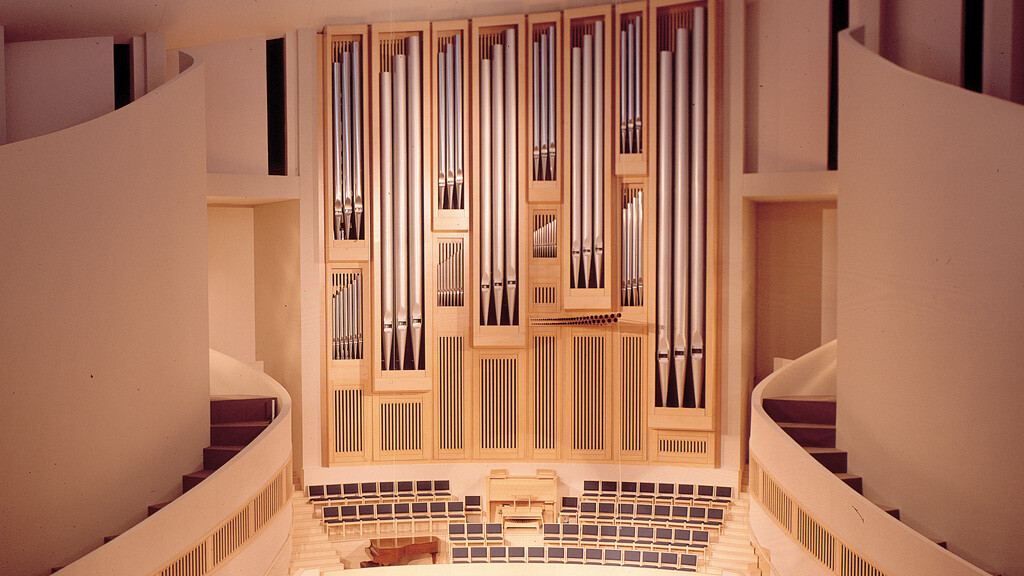
The 102-rank, 5,685-pipe organ is among the largest free-standing organs in the USA, befitting this spectacular venue for music and worship. Organists regularly give free demonstration recitals. Builder: Casavant Frères Limitée, St-Hyacinthe, Quebec, Canada
The Temple Organ
Transcript
Narrator
The sanctuary is also home to a magnificent organ. The Temple organ has 5,685 pipes. You can see many of the larger ones here, although most of the intricacies are hidden behind this 50-foot-tall organ cabinet.
The Temple organ is the 3,700th built by the Canadian manufacturers Casavant Frères of St.-Hyacinthe, Québec. The 4 manual keyboards have natural keys of ebony and sharps of rosewood with bone caps. The pipes of the Trompette en chamade are easily seen. They are made of polished copper and project horizontally into the room.
Most of the organ pipes are hidden behind the organ case which measures 40 feet wide, 50 feet tall, and 8 feet deep. The Temple organ has 5,685 pipes arranged in 102 tonal sets called ranks. The largest pipe, which you can see at the far right, is 32 feet in speaking length. The shortest, which is hidden, is 1/3 of an inch.
The organ provides a musical foundation for many Temple worship services, and frequent recitals offer even more opportunities to hear this marvelous instrument and its companion in the Community of Christ Auditorium.
Tour Guide
Select one of our Temple Sanctuary options to hear more about this space.
Otherwise, exit the doors to the right and select “Redeemer of the World” to continue the tour.
Organ Demonstration
Transcript
Tour Guide
[The Spirit of God by the Organ]
Tour Guide
Exit the doors to the right and select “Redeemer of the World” to continue the tour.
Stop 16
Redeemer of the World and Stained Glass Window
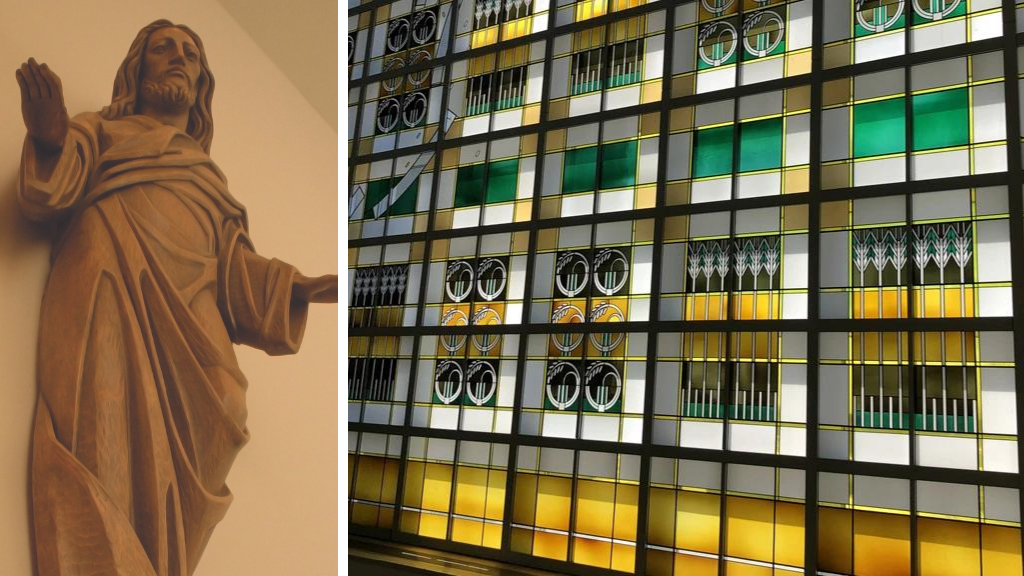
The nine-foot wooden sculpture of Jesus watches over us as we go into our communities around the world to share the peace of Jesus Christ. “Go therefore and make disciples of all nations, baptizing them in the name of the Father and of the Son and of the Holy Spirit…” (Matthew 28:19 NRSV). Artist: Giuseppe Runggaldier
Redeemer of the World
Transcript
Narrator
Mounted at the top of these stairs, this 9-foot wooden sculpture of Jesus, Redeemer of the World blesses us as we prepare to leave the Temple and share the peace of Jesus Christ with the world.
We also encounter a 50-foot stained glass window depicting Christ’s call to his followers to spread the Gospel. In John chapter 4, verse 35, we read: “But I tell you, look around you, and see how the fields are ripe for harvesting.” [John 4:35 NRSV]
Panels of stylized rice and wheat represent the Eastern and Western cultures and clear sweeps of glass evoke the active harvesting, a metaphor for the call to invite people to Christ’s mission of justice and peace throughout the world.
The window was designed by artist David Wilson of South New Berlin, New York. The colored glass was hand-blown in Germany. The window was fabricated in Oneonta, New York by D. Hallberg’s stained glass studio and the glass was transported over 1,000 miles to Independence for installation.
Tour Guide
For commentary from artist David Wilson and to hear the building process from fabricator Doug Hallberg, please select “Artist David Wilson and Fabricator Doug Hallberg.”
Otherwise, select “The Mission Prayer” to continue the tour.
Artist David Wilson and Fabricator Doug Hallberg
Transcript
David Wilson
To kind of create a feeling of harvesting, I liked the idea of using big, clear glass arcs that cut through the whole design, all the way down into the bottom as kind of sickles of light.
Doug Hallberg
Each template is put on top of a piece of glass and the method I use here is “cut by feel” where you take the wheel, the glass cutter, and you simply go around, very precisely, the edge of each template. And each piece of glass is carefully cut, then it can be leaded together, and that process is accomplished by working on top of the cartoon; it’s placed on the bench, squared, and then using lead, 100% lead extruded came, is put around the perimeter.
The window is actually built like a puzzle. Once this is carefully put together, each flange of the lead is opened up and the adjoining piece of lead is, is sort of pressed down at its end and it’s tucked under, rather than just butted up against, so that we can achieve a joint that is very strong and will, will last somewhere in the neighborhood of 200+ years. We’re careful to construct the window in the most enduring fashion.
Tour Guide
Select “Mission Prayer” to continue the tour.
Stop 17
Mission Prayer
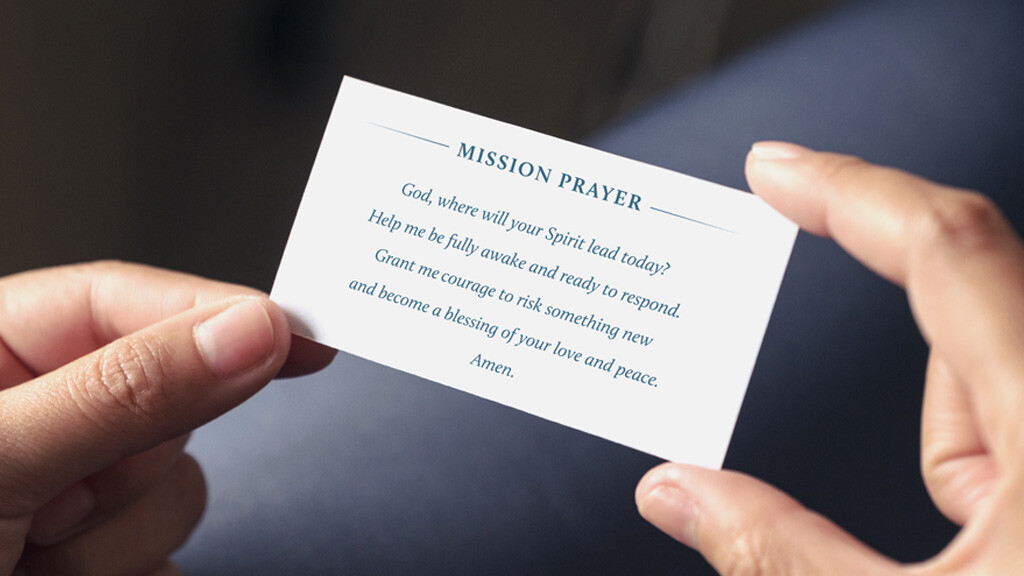
We go into the world to share the good news of the gospel as symbolized by an award-winning, 50-foot, stained-glass window representing the harvest of wheat and rice, the food staples of the Eastern and Western world. “…look around you and see how the fields are ripe for harvesting” (John 4:35 NRSV). Artist: David Wilson
Mission Prayer
Transcript
Ron Harmon
Hello. I’m Ron Harmon, President of the Council of Twelve Apostles. Our experience of worship and gathering here in the Temple prepares Community of Christ to be a community of practice and not simply a community of belief. The Mission Prayer is a spiritual practice that helps us discern God’s invitation to live Christ’s mission in a world that is constantly struggling to find meaning and peace.
Along with dwelling in the Word of Scripture, and sharing together about individual efforts to be faithful disciples, The Mission Prayer helps us to be mindful of God’s call to us—and our desire to be responsive to that call.
The prayer is short and gets directly to the point: “God, where will your Spirit lead today? Help me be fully awake and ready to respond. Grant me courage to risk something new and become a blessing of your love and peace. Amen.”
The prayer calls us to awaken to God’s movement in us, among us, and ahead of us, to risk new questions, new relationships, new compassionate actions, and new forms of community, and to bless as we generously share and receive God’s love and peace with others and the earth.
Tour Guide
Select “World Plaza” to continue the tour.
Stop 18
World Plaza
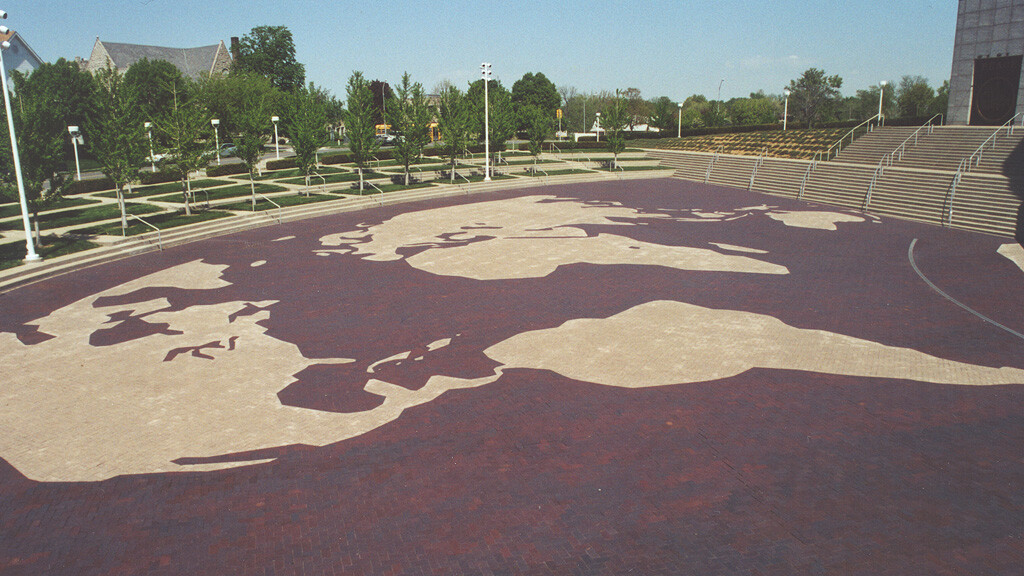
The Temple is a house of prayer for all nations. The World Plaza brick inlaid map of the world at the west entrance reminds us of our commitment to proclaim Jesus Christ and promote communities of joy, hope, love, and peace throughout the world.
World Plaza
Transcript
Stassi Cramm
I’m Stassi Cramm, and I serve as a member of the First Presidency of Community of Christ. The First Presidency is a three-person team made up of the church’s Prophet-President and two counselors who work together to provide primary leadership to the church. Thank you for visiting the Community of Christ Temple. As we experience this sacred space we feel blessed to go out from here to share Christ’s peace with the world.
Outside these windows, we see the World Plaza where 16,500 colored paving stones form an immense map of the earth. The Temple is a house of prayer, healing, and learning, open to all people. The World Plaza sends us from the Temple into the world to build God’s kingdom here on earth, sharing the peace of Jesus Christ, and the message of the Gospel with all nations.
Wherever you are from and wherever you are going, we hope that you are committed to the pursuit of peace and are blessed with the assurance that God has an abiding love for you, and all creation.
Tour Guide
To hear French Polynesian members of the church sing about that hoped for day when God’s kingdom on earth is a reality, select “French Polynesian Choir Singing Tiona Nehenehe.”
Otherwise, select “Thank you for visiting the Community of Christ Temple” to complete this portion of the tour.
French Polynesian Choir Singing Tiona Nehenehe
Transcript
[French Polynesian Choir Singing Tiona Nehenehe]
Tour Guide
Select “Thank you for visiting the Community of Christ Temple” to complete the tour.
Stop 19
Thank You
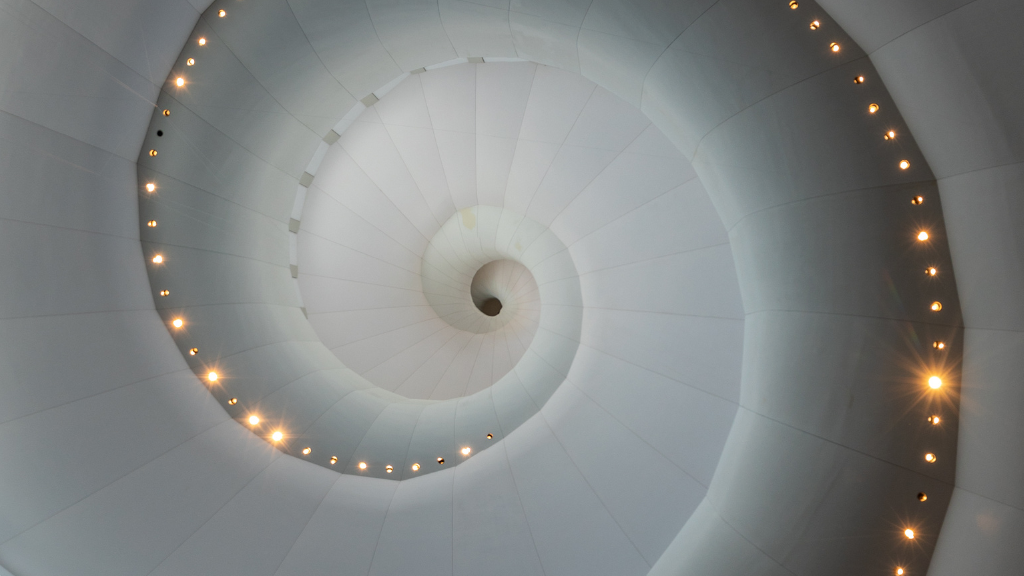
Thank you for visiting the Community of Christ Temple. Browse our website to learn more about us and search for congregations and online ministries. Again, thank you for your visit. We invite you to return and visit us again. May the Peace of Jesus Christ go with you as you leave this space to be agents of peace in the world!
Thank you for visiting the Community of Christ Temple
Transcript
Tour Guide
Please go down the elevator or stairs and return any devices you may have borrowed for this tour to the first-floor information desk. If you have any further questions, please ask the attendant.
Visit the Temple Museum to learn more about our church history and heritage.
There are many things to see on the outside of the Temple, so feel free to continue your visit on the World Plaza, or the PEACE doors overlooking the World Plaza, or by walking the labyrinth, located at the top of the ramp on the Temple rooftop.
If you would like to know more about Community of Christ, please visit our website at www.CofChrist.org. Here, you can also search for a Community of Christ congregation near you.
Again, thank you for your visit. We invite you to return and visit us again.
May the Peace of Jesus Christ go with you as you leave this space to be agents of peace in the world!



